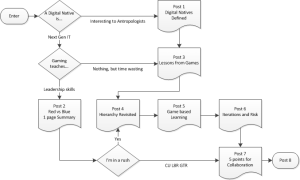This post is #2 in an collaborative eight part series by Brad Szollose and Rob Hirschfeld about how culture shapes technology.
SUBTITLE: Your series is TOO LONG, I DID NOT READ It!
This post is #2 in an collaborative eight part series by Brad Szollose and I about how culture shapes technology.
Your attention is valuable to us! In this section, you will find
the contents of this entire blog series distilled down into a flow chart
and one-page table. Our plan is to release one post each Wednesday at 1
pm ET.
Graphical table of contents
The following flow chart is provided for readers who are looking to maximize the efficiency of their reading experience.

If you are unfamiliar with flow charts, simply enter at the top left oval. Diamonds are questions for you to choose between answers on the departing arrows. The curved bottom boxes are posts in the series.
Culture conflict table (the Red versus Blue game map)
Our fundamental challenge is that the cultures of Digital Immigrants and Natives are diametrically opposed. The Culture Conflict Table, below, maps out the key concepts that we explore in depth during this blog series.| Digital Immigrants (N00Bs) | Digital Natives (L33Ts) | |||
| Foundation: Each culture has different expectations in partners | ||||
| Obey Rules They want us to prove we are worthy to achieve “trusted advisor” status. They are seeking partners who fit within their existing business practices. |
Test Boundaries They want us to prove that we are innovative and flexible. They are seeking partners who bring new ideas that improve their business. |
|||
|
||||
| Permission Driven Organizational Hierarchy is efficient Feel important talking high in the org Higher ranks can make commitments Bosses make decisions (slowly) |
Peer-to-Peer Driven Organizational Hierarchy is limiting Feel productive talking lower in the org Lower ranks are more collaborative Teams make decisions (quickly) |
|||
|
||||
| Formalized & Structured Waits for Permission Bounded & Linear Requirements Focused Questions are interruptions |
Casual & Interrupting Does NOT KNOW they need permission Open Ended Discovered & Listening Questions show engagement |
|||
|
||||
| Obeys Rules Avoid Risk—mistakes get you fired! Wait and see Fear of “looking foolish” |
Breaks Rules Embrace Risk—mistakes speed learning Iterate to succeed Risks get you “in the game” |
|||
|
||||
| Knowledge is Concentrated Expertise is hard to get (Diploma) Keeps secrets (keys to success) Quantitate—you can measure it |
Knowledge is Distributed and Shared Expertise is easy to get (Google) Likes sharing to earn respect Qualitative—trusts intuition |
|||
Hopefully, this condensed version got you thinking. In the next post, we start to break this information down.
Tune in Next Wednesday...

Our point of view: About the authors
Rob Hirschfeld and Brad Szollose are both proud technology geeks, but they’re geeks from different generations who enjoy each other’s perspective on this brave new world.
 Rob is a first-generation Digital Native. He grew up in Baltimore reprogramming anything with a keyboard—from a Casio VL-Tone and beyond. In 2000, he learned about server virtualization and never looked back.
Rob is a first-generation Digital Native. He grew up in Baltimore reprogramming anything with a keyboard—from a Casio VL-Tone and beyond. In 2000, he learned about server virtualization and never looked back.
In 2008, he realized his teen ambition to convert a gas car to run electric (a.k.a. RAVolt.com). Today, from his Dell offices and local coffee shops, he creates highly disruptive open source cloud technologies for Dell's customers.
 Brad is a Cusp Baby Boomer who grew up watching the original Star Trek series, secretly wishing he would be commanding a Constitution Class Starship in the not-too-distant future.
Brad is a Cusp Baby Boomer who grew up watching the original Star Trek series, secretly wishing he would be commanding a Constitution Class Starship in the not-too-distant future.
Since that would take a while, Brad became a technology-driven creative director who cofounded one of the very first Internet development agencies during the dot-com boom. As a Web pioneer, Brad was forced to invent a new management model that engaged the first wave of Digital Workers.
Today, Brad helps organizations like Dell close the digital divide by understanding it as a cultural divide created by new tech-savvy workers ... and customers.
Beyond the fun of understanding each other better, we are collaborating on this white paper for different reasons.
- Brad is fostering liquid leaders who have the vision to span cultures and to close the gap between cultures.
- Rob is building communities with the vision to use cloud products that fit the Digital Native culture.




No comments:
New comments are not allowed.